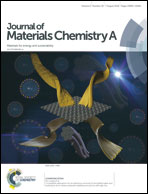In situ study of strontium segregation in La0.6Sr0.4Co0.2Fe0.8O3−δ in ambient atmospheres using high-temperature environmental scanning electron microscopy†
Abstract
Samples of the solid oxide fuel cell cathode material La0.6Sr0.4Co0.2Fe0.8O3−δ (LSCF) were annealed using High-Temperature Environmental Scanning Electron Microscopy (HT-ESEM) from room temperature to 1000 °C in atmospheres of pure oxygen, pure water and ambient lab air. Image series of each heat treatment were taken where microstructural changes were observed and compared between samples. Strontium segregation rate was found to be significantly increased in the presence of pure water as compared to pure O2 and ambient air. Electron backscattered diffraction (EBSD) was performed in order to assess the effect of crystal orientation on particle formation and surface sensitive chemical analysis techniques were used to determine the chemical changes at the grain surface as a result of the different heat treatments. It was shown that crystal orientation affected the nature and growth rate of strontium-based particles, however, due to the pseudo-symmetry of La0.6Sr0.4Co0.2Fe0.8O3−δ, precise crystal orientation relationships could not be determined. The chemical composition of the grain surface was found to be approximately equal under each atmosphere.



 Please wait while we load your content...
Please wait while we load your content...